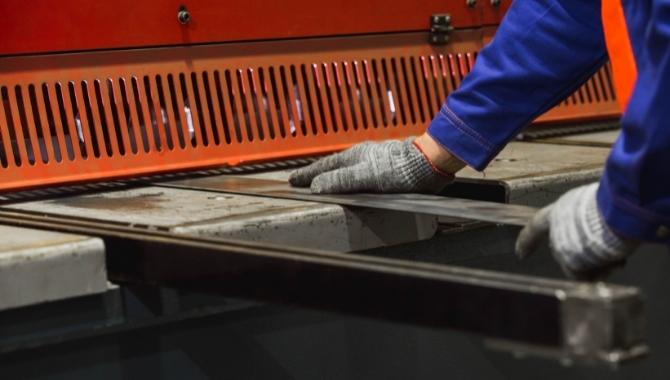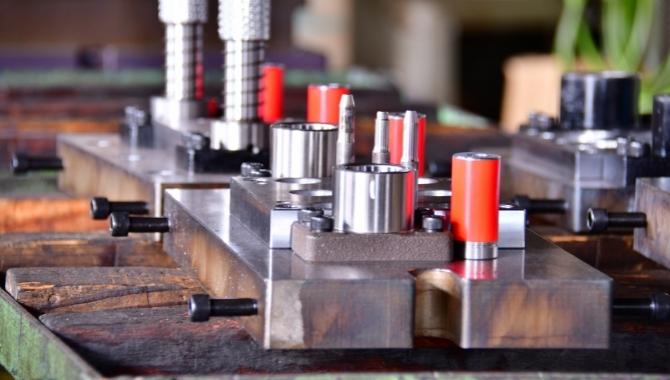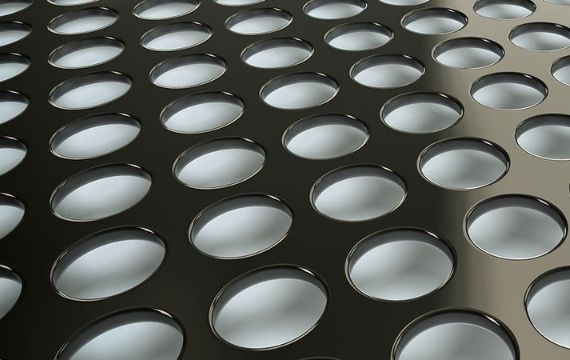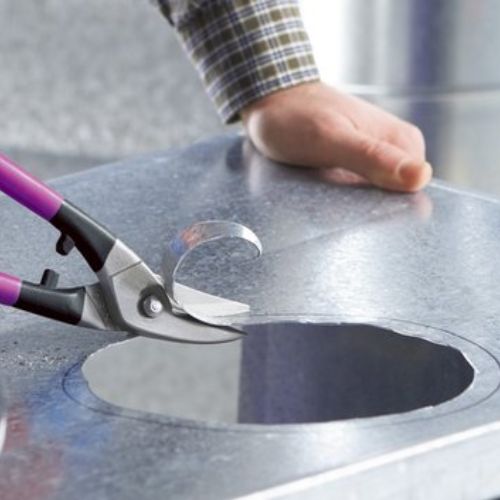What is Sheet Metal Shearing?
Sheering is a method used to cut large sheet metal into smaller, more manageable pieces for use in metal fabrication.
Shearing occurs when two opposite external forces push against an object from both sides. The force calculation created causes the object to break, separating it into two distinct pieces.
Sheet Metal Shearing Materials
With sheet metal shearing, you can process virtually all materials. Depending on your custom sheet metal shearing needs, you can use stainless steel, bronze, copper, brass, aluminum, and mild steel, amongst others.


Sheet Metal Shearing Process
The process involves:
i. First, sheet metal is selected, and the required dimensions needed for the final product are measured using a ruler or tape measure.
ii. Next, mark the sheet with a sharpie or score the material with a sharp-edged tool.
iii. Third, place the sheet metal on the bench, lining up the marks with the lower blade. The machine has holders installed to keep the sheet metal in place during the sheer and make a clean cut.
iv. Finally, clump down on the lever to force the upper blade down and shear the sheet. The cut piece will be collected on a tray on the other side.
Sheet Metal Shearing Vs. Die Cutting


Sheet metal shearing is a process that uses linear motion to cut metal sheets into desired shapes. Two sharp blades are mounted on a shearing machine, and the metal sheet is placed between them. As the blades move toward each other, they cut through the metal sheet to create a clean, straight edge.
In contrast, die-cutting uses a die, which is a sharp, hardened tool to cut metal sheets into desired shapes. The die is mounted on a machine, and the metal sheet is placed under it. The cutting press applies pressure as the die comes down on the sheet and punches through to create the desired shape. Here is how sheet metal shearing compares to die-cutting
- Shearing leaves a smooth, burr-free edge, while die-cutting can leave a slightly jagged edge.
- Shearing is a faster and cheaper process than die-cutting because creating the die requires extra time and effort.
- You spend less on shearing compared to die-cutting as it can be expensive to purchase a die.
- Shearing is typically used for larger pieces of sheet metal, while die-cutting is better suited for smaller pieces.
- Die-cutting is more precise than shearing as it can create more complex shapes. In contrast, shearing can only cut straight edges.
Sheet Metal Shearing Vs. Sheet Metal Blanking


In sheet metal fabrication, you can use shearing or blanking. Shearing is a cutting process that uses two opposing sharp blades to cut through metal, much like a pair of scissors. It results in a straight, clean cut.
Blanking, on the other hand, is a process where a punch presses down onto the metal and pushes out a new piece. The punched-out part is the workable piece, also called a blank. The main differences between these processes are:
- Sheet metal shearing is better suited for projects requiring simple uniform cuts. Blanking is more precise, making it ideal for projects where accuracy is crucial.
- Shearing is faster and easier to set up compared to blanking. Hence, it is a better option when time is of the essence.
- Shearing produces less waste than blanking since you must leave an allowance on the metal for the next blank.
- Blanking can produce custom designs of various sizes and shapes. In contrast, shearing only fabricates designs with straight edges.
Sheet Metal Punching Vs. Sheet Metal Shearing


A sheet metal punching tool is a process that uses a specialized machine to cut out holes or shapes from a piece of metal. The machine places a die on the metal and presses down to cut out the desired hole. The punched-out pieces are the scrap in this process.
In contrast, sheet metal shearing uses two blades to cut through the metal. Unlike punching, there is no scrap material left behind. This process simply trims the entire sheet to size. The best method for your project depends on a few factors. Here are some key considerations:
- Shearing is typically faster than punching, so it is ideal for projects that need to be finished quickly.
- Shearing is typically less expensive and produces less waste than punching. This makes it a good option for budget-conscious projects.
- Pneumatic punching is generally more accurate than shearing, making it a good choice for projects that require precise measurements.
- Punching can create more intricate shapes than shearing, so it is better suited for complex designs.
Shearing Operations In Sheet Metal Work


Shearing cuts metals by applying force on both sides of a sheet panel at the same time from opposite directions. It resembles using a pair of scissors where all the points on the blades meet simultaneously.
Shearing operations follow these steps to ensure that your cuts are straight and accurate
- The first step is setting up the shear by adjusting the blade angle, cutting depth, and back gauge. Ensure that the blades are sharp and firmly mounted for a clean cut.
- The next step involves marking the cutting line on the metal sheet. You can use a pencil, chalk, or a sharp metal tool. This marking should be clear as it will help set up the cutting line in the next step.
- The third step is to position the metal sheet on the shear by aligning the cutting line with the blade. The cutting line is usually positioned along the edge of the shear bed to ensure the cut is straight and accurate.
- Once in position, the next step is clamping the metal sheet. It ensures that the sheet is not dislodged by the shearing force and maintains a straight and clean cut.
- The fourth step is to start the shearing process. It is done by moving the cutting blade through the metal sheet.
- After the cut is made, remove the cut piece of metal from the shear. The final step is to check the cut for accuracy and clean up any burrs or sharp edges.
Sheet Metal Shearing Clearance Defects

This shearing defect occurs when the cut piece twists into a scroll shape. It results from an excessive rake angle. It is an angle between the cutting edge and the workpiece. Malleable metal sheets are more prone to twisting than rigid ones if the rake angle is too steep.
It applies excessive pressure to the metal plate, turning it along its axis. Twisting can be fixed by correcting the mounting angle of the upper blade according to the specifications of the material being cut. This adjustment automatically adjusts the rake angle.

The proper shear blade gap depends on the material being cut. This gap creates perfectly straight edges on the workpiece. Deformed edges are caused by having an incorrect blade sheer gap and damaged or blunt blades causing uneven pressure on the sheet during the sheering process.
Alternatively, if the clamps are not holding the metal down properly, it may move during the shear operation, causing uneven edges. You can avoid deformed edges by adjusting the blade gap to the specifications set for the cut metal. The machine’s operating manual contains this information. Additionally, check the sharpness of the blade as this helps adjust the bending & rolling machine pressure.

A piece with a bowing defect is identifiable by the slight rising of its edges. Thin metal sheets and strips are prone to this problem, particularly if the blades apply excessive force. The best way to avoid this defect is to ensure that the sheet metal is held down firmly during the shear. Adjusting the rake angle for thin metal strips to reduce the force generated during the cut also solves this issue.

Cambering produces a concave or convex shape on the final piece caused by varying thicknesses in the sheet’s width. It occurs when more pressure is applied to the middle of the sheet than the edges. You can avoid this issue by changing the grain direction of the materials when cutting. It counteracts the uneven force applied to the sheet, keeping it level. Correcting the rake angle can also reduce cambering by adjusting the shear force.
Sheet Metal Shearing Advantages

Shearing makes cleaner cuts than traditional methods that use torches or saws. The edge is cleaner and more precise since shearing cuts the sheet metal in one sweeping motion. Additionally, the sheet is held fast to avoid movement, which helps achieve precision.

This method is efficient as very little waste is produced with shearing compared to other metal fabrication processes. Besides, the bench shear creates a break at the precise spot where it is needed. Therefore, no chips or cutouts are produced from this process.

Shearing does not require heat to work. The shearing machine only requires that force be applied to push the blades together and break the sheet metal in two. It also means that the metal is less prone to deformation or structural changes with shearing as no heat is applied.

This process is price-effective, especially for mass production, requiring the production of many similar pieces. It takes mere seconds to cut out a piece with this method.

Sheet metal shearing is suitable for cutting various metal material types and thicknesses. The blades are easily adjustable to suit any material. Making these adjustments is also relatively straightforward. Additionally, the machine usually comes with a manual to instruct you on adjusting the blades for different materials.




